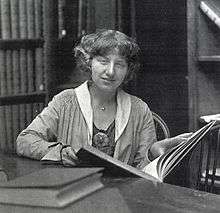Lutah Maria Riggs
| Lutah Maria Riggs | |
|---|---|
 | |
| Born |
October 31, 1896 Toledo, Ohio |
| Died |
March 8, 1984 (aged 87) Montecito, California |
| Nationality | United States |
| Alma mater | University of California, Berkeley |
| Occupation | Architect |
Lutah Maria Riggs, FAIA (October 31, 1896 – March 8, 1984) was an American architect who worked for several decades in the Southern California region. She was the first licensed female architect in Santa Barbara,[1] and the first woman in California to be named a Fellow of the American Institute of Architects.[2]
Early life and education
Lutah Maria Riggs was born in 1896 in Toledo, Ohio, the only child of a physician and a homemaker. Her father died when she was a child. She graduated from Manual Training High School in Indianapolis, Indiana in 1914.[3] Later that same year, Riggs and her mother moved to Santa Barbara to join her stepfather.
Riggs completed her initial undergraduate studies at Santa Barbara City College, from which she received a certificate in 1917. She then won a scholarship to attend the University of California at Berkeley, from which she received her B.A. in Architecture in 1919. Riggs completed graduate coursework at Berkeley in 1920, but moved back to Santa Barbara before finishing her graduate degree to be closer to her ailing mother.[3][4]
Career
Riggs began her architectural career in 1920, working in Susanville as a draftswoman and designer for architect Ralph D. Taylor.[4] After working for Taylor for a few months, she moved to Santa Barbara and worked as a draftswoman for the noted Spanish Revival architect George Washington Smith. Smith and his wife were so taken by Riggs that she became somewhat of a surrogate daughter to the couple.[5] She travelled with the Smith family on their architectural study trips to Mexico in 1922, and Europe in 1924.[3] Also in 1924, Riggs was made partner in the firm, and given the title of chief draftswoman.[3] Riggs eventually became extremely influential in much of the firm's design work, and in some cases was fully responsible for the design of commissions. She contributed significantly to the designs for some of Smith's most well-known buildings, including the Lobero Theatre, El Paseo historical complex, and Casa del Herrero.[3][4][6]
In 1928, Riggs obtained her architectural license. She continued to work for George Washington Smith through 1930, when Smith had a sudden heart attack and died. After a short stint working in partnership with colleagues, in 1931 Riggs started her own firm, which she ran until 1942.[4] During these years Riggs completed a fair amount of residential work for wealthy clients in the Santa Barbara/Montecito area, as well as some commercial/institutional work, such as the Blaksley Library at the Santa Barbara Botanic Garden (1942). She also designed modest residences for the Rolling Hills development on the Palos Verdes peninsula south of Los Angeles. During World War II, Riggs worked briefly as a set designer on MGM and Warner Brothers films.[3]
In 1946 Riggs began a partnership with Arvin Shaw, continuing to focus on residential work, though in a more modernist style, as seen in her design for the Alice Erving house in Montecito (1951). The Erving house is well known for its unique siting that maintains privacy while opening up to expansive views of the surrounding mountains, as well as for its floor-to-ceiling windows and vaulted ceilings. In 1951, she left the partnership to work on her own, continuing to do residential as well as some commercial work. One of her most famous buildings from this era is her design for the Santa Barbara Vedanta Temple (1956), noted for its reflection of early South Indian wooden temple architecture.[7]
In addition to running her practice, Riggs was active in her local AIA chapter, and served on the California Architects' Board as both a member and a Commissioner.[2] In 1960, she was named a Fellow of the American Institute of Architects for "excellence in design and service to the profession". In 1967, the Los Angeles Times named her "Woman of the Year", the first architect to be chosen for this honor.[5] Riggs continued to practice architecture through 1980, and died in Montecito, California in 1984.[4] The Architectural Foundation of Santa Barbara has funded a yearly scholarship in Riggs' name, to be given to architectural students, with special consideration for women.[1]
References
- 1 2 "Lutah Maria Riggs". www.afsb.org. Retrieved 2012-07-31.
- 1 2 "Women In Architecture". Arvha.asso.fr. Retrieved 2012-02-23.
- 1 2 3 4 5 6 Ware, Susan; Radcliffe Institute (2005). Completing the Twentieth Century. Notable American Women: A Biographical Dictionary. 5. Belknap Press. ISBN 978-0-674-01488-6.
- 1 2 3 4 5 "Lutah Maria Riggs papers" (PDF). Architecture and Design Collection, Art, Design & Architecture Museum. Retrieved 1 May 2013.
- 1 2 "ArchitectDB - Architects". Digital.lib.washington.edu. Retrieved 2012-02-23.
- ↑ Gebhard, Patricia (2005). George Washington Smith: Architect of the Spanish-Colonial Revival. Gibbs Smith. ISBN 1-58685-510-7.
- ↑ "Vedanta Society of Southern California". Vedanta.org. Retrieved 2012-02-23.
- Bibliography
- Gebhard, David (1992). Lutah Maria Riggs: a Woman in Architecture 1921–1980. Capra Press. ISBN 978-0-88496-352-3.
External links
- The Blaksley Library at the Santa Barbara Botanic Garden
- Alice Erving house remodel – Architect
- Alice Erving house remodel – Contractor
- Alice Erving house remodel – Real Estate Agent
- Alice Erving house – slideshow on YouTube
- Section 8. Lutah Maria Riggs, Architect of the Vedanta Temple